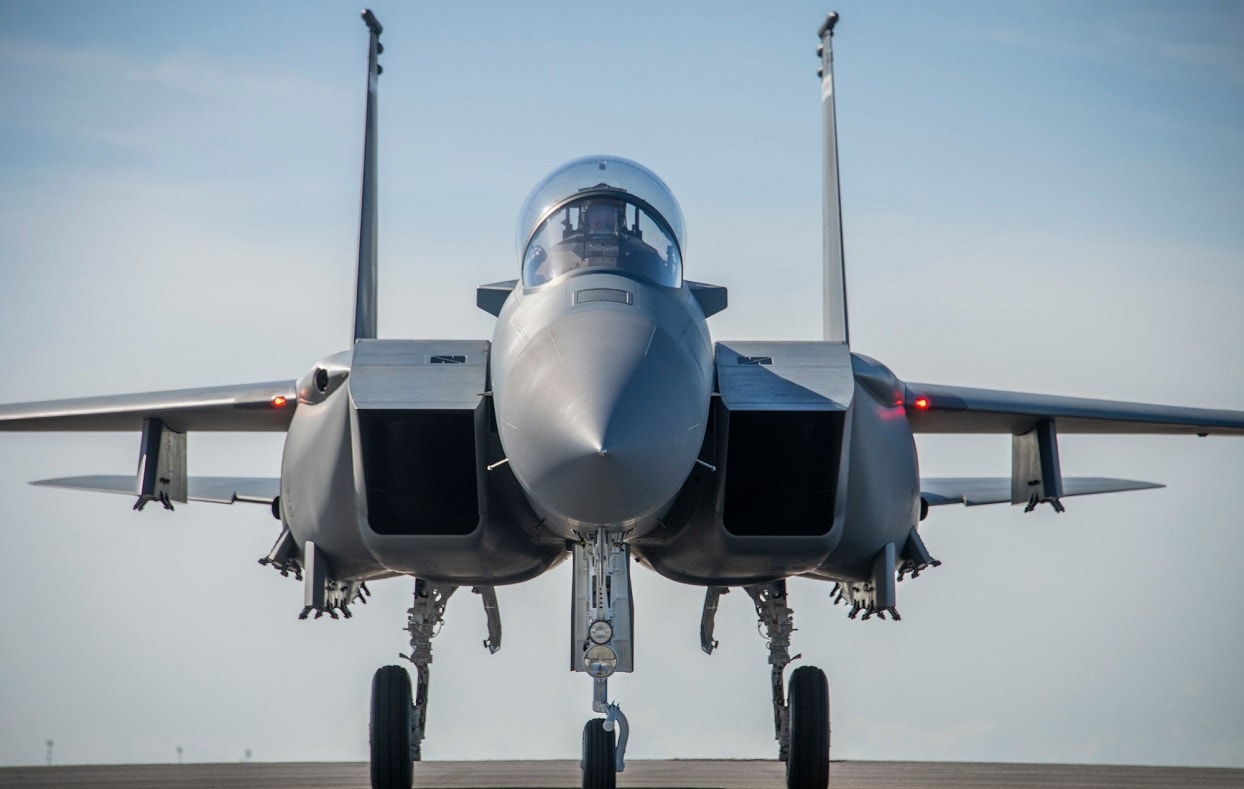While we all stand in awe today over the stealth capabilities of the F-22 and F-35 stealth fighters, it was the F-15 that was tasked with taking on Russia during the very heights of the Cold War. And she is still flying today:
Among the 50 or so fighter designs to take to the skies for different nations throughout the 1970s and ’80s, the McDonnell Douglas F-15 Eagle stands head and shoulders above the rest. With a reported air combat record of 104 wins with zero losses, the Eagle’s legendary reputation as the champion of the skies has been earned across multiple conflicts under multiple national banners… So you might be surprised to learn that America’s most prolific air superiority fighter actually entered service as the underdog.
It was purpose-built to square off against what Western governments believed was a new Soviet super-fighter with unparalleled speed and dogfighting capabilities. This powerhouse jet had the largest engines ever affixed to a fighter, capable of pushing the aircraft to speeds in excess of Mach 3 and to altitudes higher than 80,000 feet… and as far as U.S. defense officials were concerned, it didn’t have a single peer in the American arsenal. It was this fear that drove the design of the now-legendary Eagle.
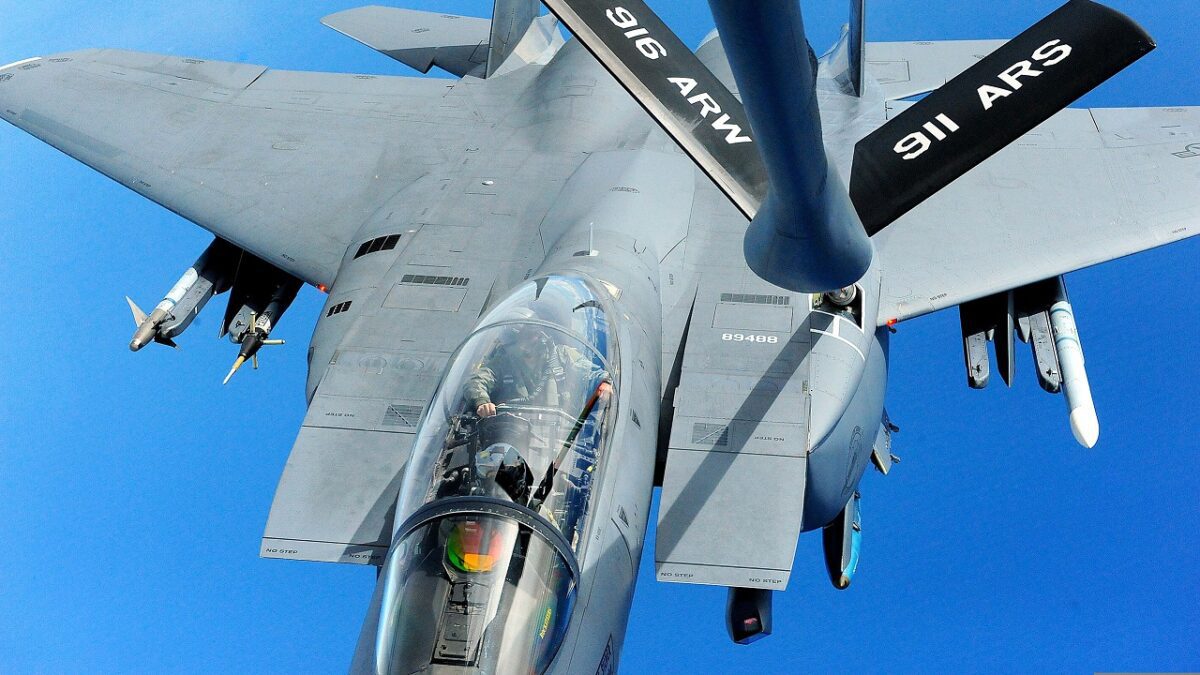
F-15E fighter. Image Credit: Creative Commons.
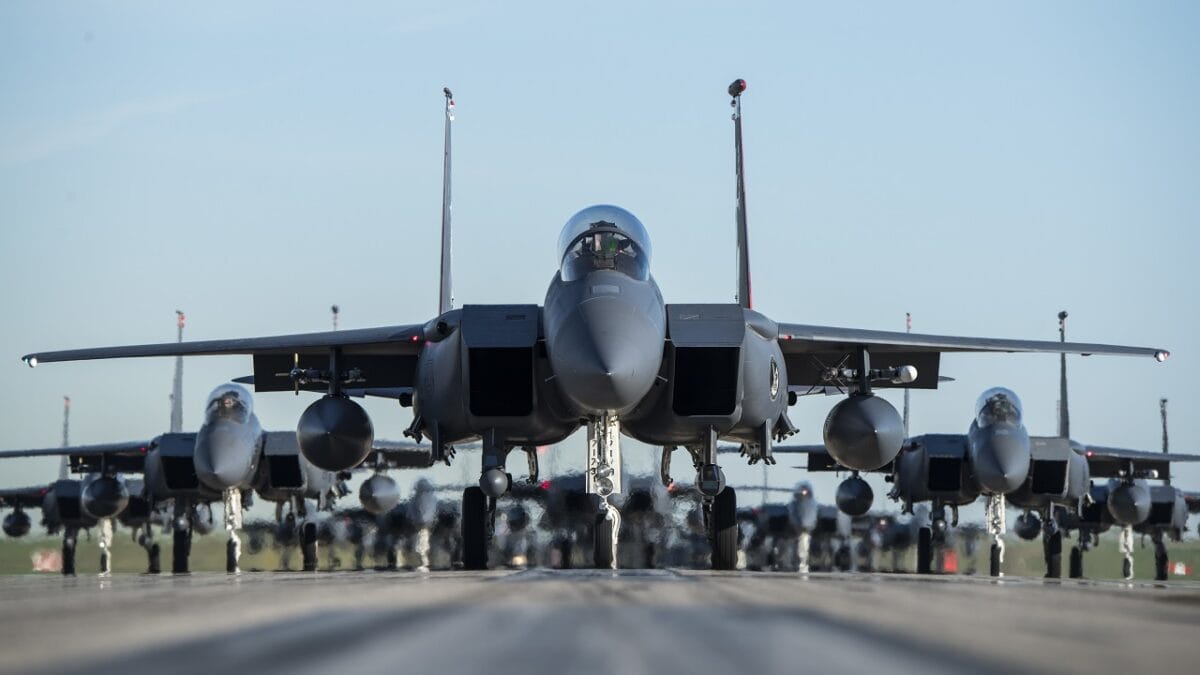
F-15E Strike Eagles taxi into formation June 12, 2019, at Mountain Home Air Force Base, Idaho. This was a rare opportunity to capture the Gunfighter family, including the 391st, 389th and 428th Fighter Squadrons, before a morning flight. (U.S. Air Force photo by Staff Sergeant Jeremy L. Mosier)
But the secretive Soviet Foxbat was never really the jet America believed it to be. In a very real way, the Eagle was developed to win a fight against an imaginary jet without equal… and it became a very real fighter without equal in the process.
The effort to field the F-15 began in a world that was very different than the one it flies over today. The end of World War II had positioned the United States as the world’s most dominant power, thanks in no small part to its strong industrial base that hadn’t been ravaged by the continent-spanning conflict, but perhaps most importantly, America was the world’s sole nuclear power. But America’s atomic dominance would be short-lived—and just four years after the atomic raids on Japan, the Soviets tested their own atomic weapon for the first time.
What followed was a decade-spanning arms race that we’ve come to know as the Cold War, and when it began, the US didn’t appear to be in the lead. By 1955, the Soviet Union had matched both America’s atomic and hydrogen (or thermonuclear) bomb-making capabilities. Two years later, the Soviet Union would test the world’s first intercontinental ballistic missile, the 3,700-mile range R-7, followed just months later by the world’s first satellite, Sputnik I. America’s global supremacy was no longer assured, and for a time, the Soviet Union seemed to have taken a commanding lead.
When word of Sputnik’s launch reached the American public in 1957, a wave of concern known as the “Sputnik Crisis” washed over the nation. The tiny orbiter dominated American news media, with the New York Times famously mentioning the satellite in more than 11 articles per day between October 6 and October 31 of that year. Ten years later, in October of 1967, American defense officials would feel a similar wave of anxious concern wash over them once again… though this time, the public remained largely unaware.
That’s when the Soviet Union unveiled its newest fighter: the Mikoyan-Gurevich MiG-25.
The Foxbat Crisis — A super-fighter with “mystical capabilities”
The MiG-25 was conceived as a response to America’s nuclear-capable supersonic B-25 Hustler, but when word reached the Kremlin of America’s efforts to field a Mach 3-capable bomber in the North American XB-70 Valkyrie, the need for a high-speed interceptor aircraft became all the more pressing. The Valkyrie, of course, would never find its way into service, but by the time it was canceled in 1961, Lockheed’s legendary engineer Kelly Johnson was already hard at work on the A-12—another Mach 3 aircraft that would lead to the YF-12 interceptor design and its legendary sibling, the SR-71 Blackbird.
While Johnson’s efforts were shrouded in secrecy, the Soviet Union could see the high-speed writing on the wall. If they wanted to be able to defend their airspace against future fleets of high-supersonic American bombers, they needed an aircraft that could keep up. So the Mikoyan-Gurevich firm set to work designing a fighter aircraft that could fly fast and high enough to intercept whatever America threw at it—all while carrying a heavy payload of air-to-air missiles. And by 1965, Western intelligence agencies were already hearing rumors about a prototype Soviet aircraft dubbed the Ye-155 that was already breaking speed records.
American experts would finally get their first glimpse of this new super-fighter two years later at the 1967 October Revolution Air Show held in Russia. Near the tail end of the performance, three prototype MiG-25s screamed across the sky in clear view of the cameras. The new MiG looked like a regular fighter on steroids, with each of its two massive jet inlets almost as large as the fuselage they surrounded. Its massive exhaust outlets on the back—each nearly 60 inches in diameter—further substantiated the idea that this jet was carrying absolutely massive after-burning turbofan engines.
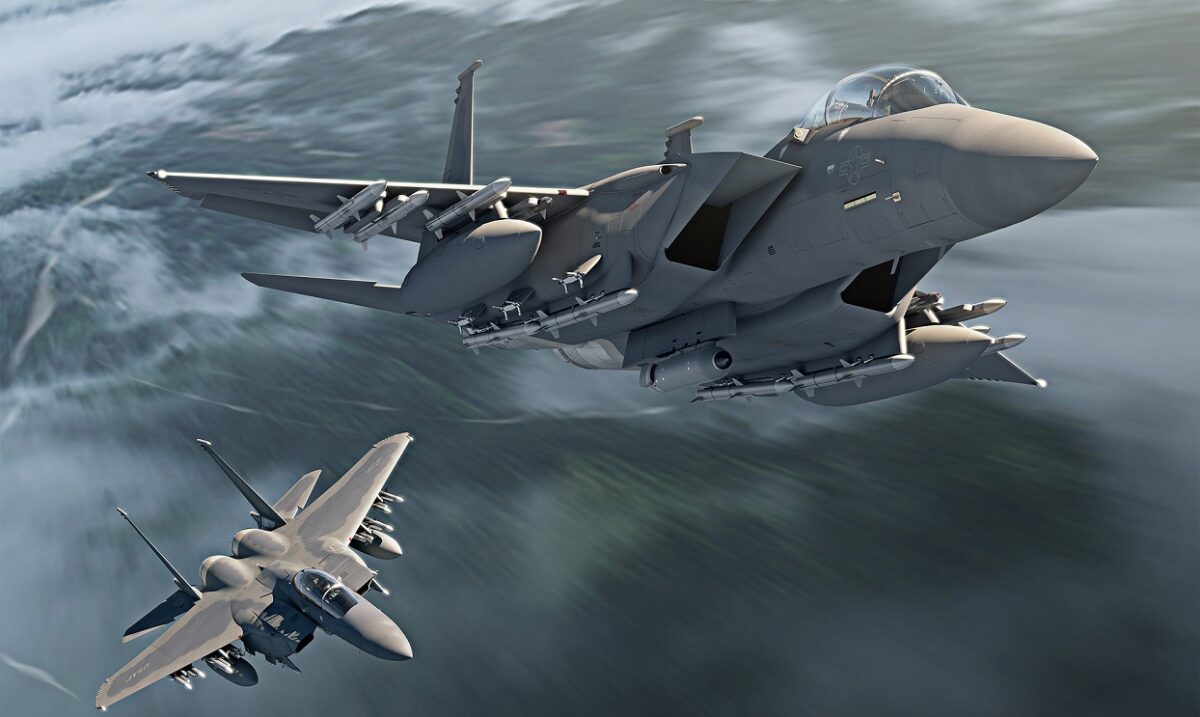
Two Boeing F-15EX fighters armed with air-to-air missiles. Boeing handout.
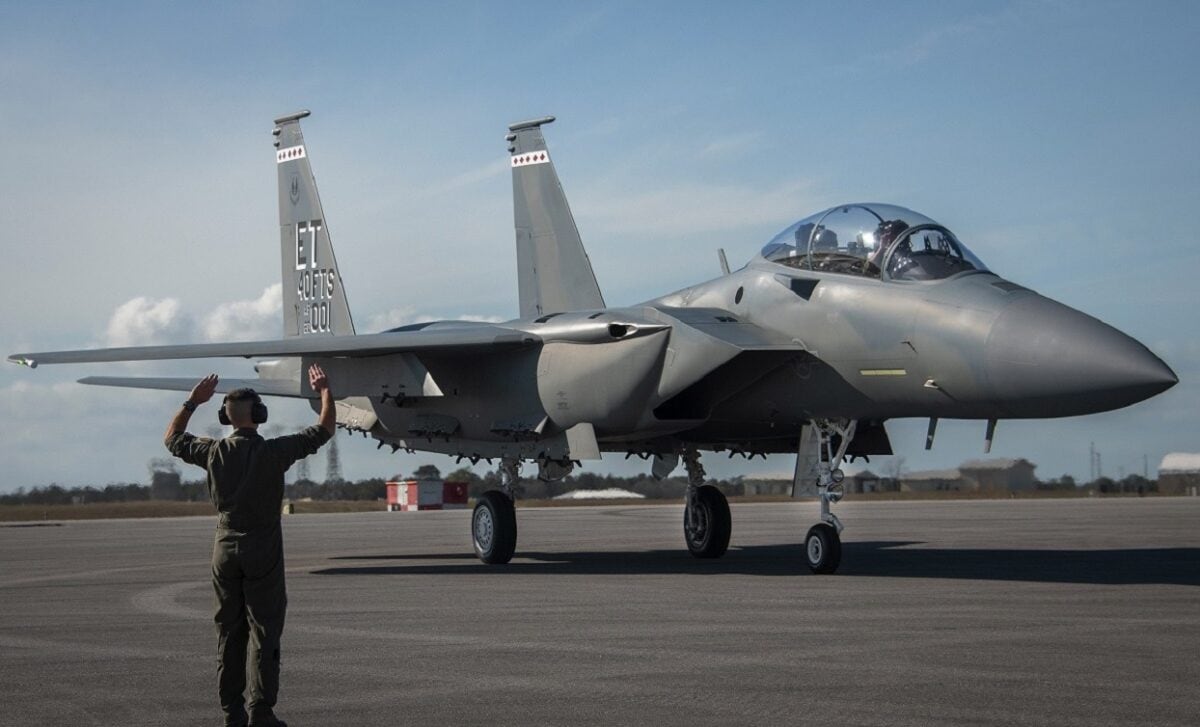
Image: Creative Commons.

A US Air Force (USAF) F-15E Strike Eagle aircraft from the 492nd Fighter Squadron, Royal Air Force (RAF) Lakenheath, United Kingdom (UK) releases a GBU-28 “Bunker Buster” 5,000-pound Laser-Guided Bomb over the Utah Test and Training Range during a weapons evaluation test hosted by the 86th Fighter Weapons Squadron (FWS) from Eglin AFB, Florida (FL).
But as massive as the engines were, the MiG-25’s huge wings, stretching some 661 square feet, worried the US even more. A larger wing area allows for greater weight distribution, so assessments at the time suggested the massive-engine packing fighter wasn’t just fast, it was also highly maneuverable. In fact, some facets of the aircraft bore a striking resemblance to proposals for America’s F-X fighter program, which itself aimed to field an acrobatic fighter, further exacerbating fears that this new fighter was an unparalleled powerhouse.
James W. Doyle, an Air Force aircraft performance analyst, was given the job of giving this terrifying new fighter a name.
“Foxbat was used for the plane that I perceived as having the most mystical capabilities,” he would later recall.
Trying to build an Eagle that can hunt a Foxbat
The effort that would lead to the F-15 Eagle began during the Vietnam War, as American F-4 Phantoms, despite their high top speeds and air-to-air missiles, struggled against older, slower Soviet fighters that could manage tighter turns and still carried guns. The need for a dedicated air-superiority fighter was clear, but it became all the more pronounced when the MiG-25 made its debut.
McDonnell Douglas won the chance to build America’s new super-jet in 1969 with a design that looked something like a fixed-wing F-14. This new fighter would be powered by a pair of Pratt & Whitney F100 afterburning turbofan engines that gave it a thrust-to-weight ratio of 1:1 in order to make it nimble in a fight. Its wide fuselage supplemented the lift provided by its 42-foot and 10-inch wingspan.
Word of the Foxbat’s unveiling, and what American experts believed it was capable of, played a significant role in the new fighter’s design. It needed to offer the speed, maneuverability, and weapons payload necessary to match the Soviet super-fighter
They equipped the new American fighter with an M61 Vulcan gun—a six-barrel Gatling-style rotary cannon—leveraging the close-combat lessons learned in Vietnam, as well as air-to-air missiles like the radar-guided AIM-7 Sparrow to give it an effective air combat 1-2 punch.
As work on the F-15 continued, America’s fears of a Soviet super-jet were exacerbated in March of 1971. Israeli radar operators picked up an unusual Soviet aircraft traveling at an astonishing Mach 3.2 at 80,000 feet, higher than the F-4 or even Soviet MiG-23 could reach. A few months later, it would happen again, but this time Israeli fighters tried to shoot the mysterious aircraft down. Instead, it simply blew past them at better than Mach 3.
The Soviets, it seemed, were well aware of Western perceptions of their newest MiG, and were more than happy to lean into them.
The following year, on July 27, 1972, the first F-15 took to the skies, and although it was an incredibly promising platform, it didn’t look like it would be able to defeat the MiG-25 on paper. The Soviet super-jet had a reported top speed of Mach 3.2 and a theoretical service ceiling of 89,000 feet. McDonnell Douglas’ new twin-engine fighter could only manage Mach 2.5 and 65,000 feet… but max speeds and service ceilings offer a glimpse into the outer limits of a fighter’s capabilities, and often fail to accurately represent what a jet can do in combat flying—with is rarely done in a drag race.
This new F-15, with nearly 50,000 pounds of thrust pouring out of its afterburning engines, nine weapon hardpoints, and advanced look-down shoot-down radar capabilities, was as nimble as it was powerful. The Americans knew it may not be able to match the MiG-25’s sheer power, but they believed it could outfight the Soviet MiG.
A defector blows the Foxbat’s super-fighter cover
On September 6, 1976, the Soviet Air Defence Forces received word that one of its pilots, Lt. Viktor Belenko, had failed to return from a training sortie in his MiG-25. Because his flight plan called for low-level flying that would prevent him from showing up on radar, no one thought anything was unusual until his aircraft didn’t come soaring over the horizon at his appointed time of return.
Unbeknownst to his unit at the Chuguyevka air base north of Vladivostok, Belenko was already long gone. The pilot had secretly stowed classified technical manuals for the aircraft in his cockpit (forbidden by Soviet regulation) and taken off straight for Japanese airspace, flying low to avoid being detected. By the time word of his MiG-25 crossing the border got back to Chuguyevka, Belenko was already being escorted into Japan’s airspace by fighters from the Japanese Air Defense Force. Belenko overshot the landing, damaging his MiG, but he survived the defection and publicly requested asylum in the United States.
It was a crushing blow for the Soviet Union—not just because they had lost one of their premiers intercept fighters and a defecting pilot (which was embarrassing enough), but because it gave Western analysts the opportunity they needed to find out the Foxbat wasn’t nearly as capable as America feared it to be.
The extreme heat caused by friction and pressure while traveling at speeds higher than Mach 3 would destroy the aluminum used in the construction of most fighters, so the MiG had to be made from tougher stuff. While America had secretly purchased titanium to construct its fleet of SR-71 Blackbirds from the Soviet Union, the Soviets themselves believed the metal was too expensive to produce in large quantities. Instead, they went with a heavier nickel-steel alloy that compromised some of the jet’s performance right off the bat.
Its giant Tumansky R-15 turbojet engines, which had originally been designed to power the TU-121 cruise missile, were similarly meant to be made from titanium, but were ultimately built using steel with silver plating in extremely hot areas. These engines were only rated for 150 hours of operation, and because of the steel used in their design, exceeding Mach 2.8 would result in serious damage. In fact, the MiG-25 spotted by Israeli radar operators exceeding Mach 3 had to have both engines scrapped after that flight.
In fact, American analysts soon learned that the Foxbat was no dogfighter at all. The aircraft had been designed and built for one purpose: to take off and climb fast enough to intercept high-speed American bombers, not to duke it out in the skies. Its avionics were also extremely dated, with antiquated vacuum tubes where Western fighters were already using transistors. The Soviet “super-jet” was indeed incredibly fast—but the Soviets had accomplished that feat through a combination of cut corners and compromises that left the Foxbat far less frightening than experts had assessed.
The F-15 Eagle, American officials would soon realize, wasn’t the underdog they feared it might be. Instead, it was clearly a far more capable aircraft than the formerly-feared Foxbat. Its high thrust-to-weight ratio, which eventually became better than 1:1, made it incredibly acrobatic without sacrificing airspeed in a turn. In fact, the Eagle was so powerful that it could actually accelerate while flying straight up like a rocket ship. It may not be able to reach Mach 3, but its ability to combine speed with maneuverability gave the F-15 all the power it needed in a boxing match.
In the years to come, the F-15 would prove its mettle in combat time and time again, largely in service for the Israeli Air Force where it would secure dozens of kills without ever being shot down. The jet proved so capable, in fact, that one Israeli pilot even managed to land his F-15 after having an entire wing torn off in a training dogfight.
Today, the F-15EX continues the Eagle’s legacy of air supremacy, and although the fighter has a famously massive radar cross-section in an era increasingly focused on stealth, it’s incredible performance nonetheless makes it one of the most feared fighters in the sky today.
Perception may be reality here on the ground, but at 1,500 miles per hour and 50,000 feet above the earth, reality has a way of catching up with you. And when it does, you’d better hope you’re in an Eagle.
Alex Hollings is a writer, dad, and Marine veteran who specializes in foreign policy and defense technology analysis. He holds a master’s degree in Communications from Southern New Hampshire University, as well as a bachelor’s degree in Corporate and Organizational Communications from Framingham State University. This first appeared in Sandboxx news.

